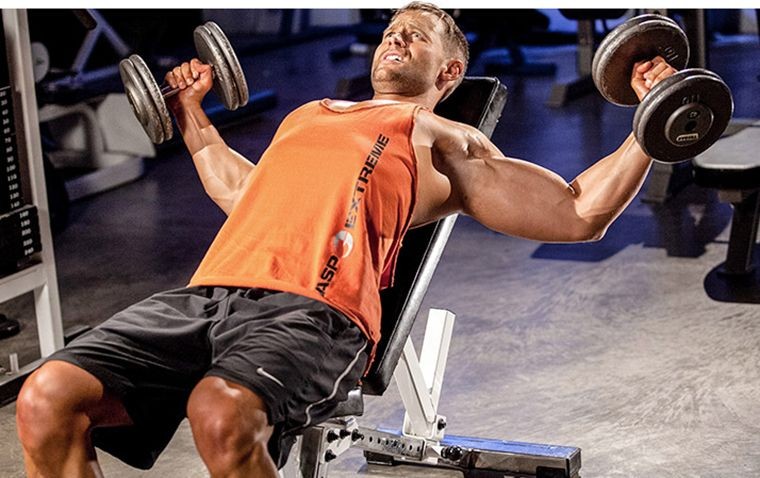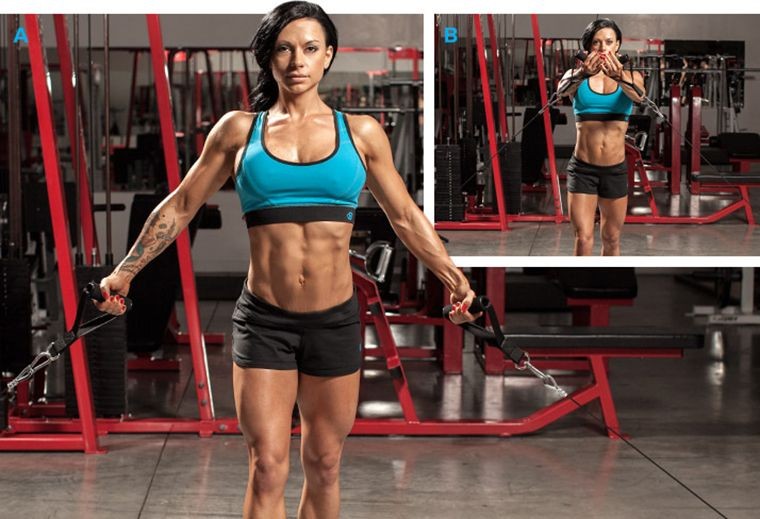Accelerate the development of the lagging top of the pectoral muscles with these 7 effective strategies, exercises and techniques!
If your workout constantly includes exercises such as bench press, bench press on an inclined or backward inclined bench and wiring with dumbbells – you have the opportunity to fully load the pectoral muscles. However, this does not mean that you will have well-developed chest. If you, first of all, while you are awake and full of energy, perform exercises on the middle chest, then you have much less strength left to train the upper and lower pectoral muscles, which in the end can cause a lag in the development of these parts.
Chest Anatomy: what are the chest muscles?
The chest consists of large and small pectoral muscles. The pectoralis major muscle is the largest muscle of the chest, it originates at an extended distance from the clavicle to the sternum, attaching to the humerus. The main function of the muscle is the flexion and adduction of the shoulder, as well as its internal rotation. The pectoralis minor muscle is a small muscle of a triangular shape, located under the pectoralis major, and as a whole duplicates its functions.
How to build your chest muscles
Yes, there’s no magic shortcut to take in building bigger muscle chests– it’s only going to happen if you work at it. But before starting a workout program, it is important that you take note of your nutrition. Give your body everything it needs to fuel up. Eat a solid meal that includes a high-protein source such as chicken, eggs, turkey, red meat, or fish; as well as a complex carbohydrate such as rice, potatoes, or oatmeal. Or you may follow a nutrition guide.
Another way to build your chest muscles is to do a variety of heavy compounds such as Squat, Deadlift, Bench Press and Overhead press. These are the fastest way to build overall strength and bulk. Do these often and heavy.
Next, is Rest. Muscles grow when they rest, not when you train them. Give your muscles time to recover and repair by resting.
It is also important to use proper techniques and include a mix of motions in your chest workout routine to make sure you work all the chest muscles. Finally, set realistic goals and be patient. Again, there’s no magic shortcut to build chest muscles – work at it!
Below are more comprehensive ways to work at it.
7 Ways To Build The Top Of The Pectoral Muscles | Huge pecs
Bodybuilders who always start with a horizontal bench press usually have flaws in the development of the upper and lower parts of the chest, which over time becomes especially noticeable. And some simply have a genetically not very developed one or another area of the chest, which makes them double their efforts when training lagging areas.
If you want to get large and strong chest muscles, then using these 7 methods you can properly build your workouts and eliminate the deficiencies in the development of the upper chest.
Read also: How to push up on the floor
1. Start with a basic (multi-joint) exercise for the upper chest
The simplest and most obvious solution to focus on lagging areas is to make them the primary goal on the day of training. Thus, instead of starting with a bench press on a horizontal bench, do incline bench press.
You will definitely notice that if you do not put the exercises for the upper chest at the end of the workout, you will be able to perform more repetitions with a heavier weight. Exposing muscle fibers to a greater load than usual, you will receive additional incentives for their growth.
As you become stronger, do not be afraid to increase weight, because nothing slows down progress more than working with the same weight and the same number of repetitions, as the muscles get used to and stop responding to the load. If you usually work in the range of 8-10 reps in the set, then at the next workout, perform (after warming up) a set or two of 6-8 reps with a heavier weight.
If there is a choice between a barbell or dumbbells, they will fit equally well. It is not recommended to use simulators, because it is the work with free weights that provides opportunities for maximum muscle growth.
2. Change the angle
In a detailed study of an inclined bench, you will notice several holes and a latch with which you can adjust the inclination. Typically, the angle of the bench is set at 30-45 degrees. A higher angle redistributes the load from the top of the pectoral muscles to the deltas. There is no mandatory rule that states that you need to use the same angle of inclination all the time; in fact, you can better develop the upper chest if you change it a little.
An adjustable bench is best used with dumbbells or in the Smith exercise machine.
Start using different tilt angles — from set to set or from workout to workout — to target your muscle fibers in different ways. Vary angles to knock off every muscle fiber and to make training more interesting.
3. Perform the second exercise for the top of the pectoral muscles

One way to focus on a lagging muscle is to do more exercises on it. However, you should not use the movement that you already did in the previous exercise.
Suppose you completed 3 sets of bench presses on an incline bench, which consisted of 8 repetitions, and now you are going to do the second exercise. Which of them diversifies the load on the target muscle? Answer Options:
A: The bench press in the Smith machine, with the bench angle and load identical to the first exercise;
B: Dumbbell bench press with a lower bench angle in 3 sets for 10-12 reps.
The correct answer is option B. If you want to optimize the training approach when working with the target muscle, you should use different equipment (barbells, dumbbells, exercise machines, etc.), change the tilt angles and the intensity of the exercise. Simply performing a second movement for the top of the chest will not be enough if all these factors are not taken into account.
4. Do not stop with muscle failure

If you want to really stimulate muscle growth, you should not be afraid of muscle failure. If you just finish the exercise after 10 repetitions, when you can do a few more, you can assume that your work set has remained incomplete.
With an increase in load, which, incidentally, should be cyclic and have periods of high and low intensity, more muscle fibers are destroyed, and those few repetitions performed after muscle failure guarantee you more muscle growth. (Caution! Continuing to perform additional repetitions can lead to overtraining). The best option is to do 1-2 repetitions of this exercise after achieving muscle failure in the last or hardest set.
Read also: Testosterone Enanthate – the king of Anabolic Steroids
There are many advanced techniques for chest training .
If you are training with a partner, consider the following:
- Forced repetition. You perform as many repetitions as you can, and then your partner provides the necessary assistance when moving the projectile (barbells, dumbbells, etc.) upwards to do a few more;
- Negative repetition. When you achieve muscle failure (you can’t do the repetition yourself), your partner raises weight, but you completely focus on the lowering phase (negative phase), which should last at least 5 seconds. This method is better suited for working with the barbell and most exercise equipment than with dumbbells.
If you don’t have a training partner, here are two ways you should try:
- Reception “rest – a pause.” Choose a weight that you can lift 7–8 times, but do only 3–4 reps, and then put the bar back on the racks. Rest for 20 seconds and perform another 3 to 4. Performing 4 to 5 such segments, alternating with a 20-second rest, will allow you to perform approximately 15 repetitions with the weight that you normally squeeze 7 to 8 times.
- Dropset. When muscle failure is achieved, instead of completing the set, you should reduce the weight by about 25 percent and continue the set until the failure again. This method is best suited for working with dumbbells and block simulators.
5. Think about a second chest workout
If you use a training split in which you train a particular muscle group no more than once every 5 days, then you have the opportunity to add a second workout for the pectoral muscles.
For a short period – no more than 6-8 weeks – perform additional training, which will allow you to focus on the lagging part of the pectoral muscles. The idea is not just to repeat the previous workout, but to qualitatively change the load with the help of new, unusual exercises and techniques. In this sense, your second workout may differ not only in the choice of exercises, but also in the number of repetitions, intensity, periods of rest and other training factors. But if you are really serious about pumping your chest we recommend this real-steroids.biz shop with quality supplements by famous pharmaceutical brands.
If you follow these principles, you can properly organize the training process.
You must make sure that you will not train any of the “bench” muscle groups directly one after another, which in the end will give enough time for recovery. An example of a poorly constructed split looks something like this: chest – the first day, shoulders and back – the second day, arms and legs – the third day, chest – on the fourth day, etc.
A break of at least 48 hours between workouts that involve such “bench” muscles such as the chest, shoulders and triceps significantly optimizes growth. The simplest split, which includes a second workout for the pectoral muscles, may look like this:
- Day 1. Chest – Triceps
- Day 2. Back – Biceps
- Day 3. Rest
- Day 4. Chest – shoulders
- Day 5. Feet
- Day 6. Rest
6. Try “new” exercises

New and unusual exercises are very important for the growth of muscle fibers in the upper chest. Assuming that you are familiar with the basic movements that involve the upper pectoral muscles, we offer several ideas on where to start:
- Bench press on an inclined bench at an angle of 45 degrees. Whether it’s a dumbbell press or a Smith machine bench press, performing a 45-degree bench press on an adjustable bench, you will breathe new life into this beloved and proven exercise.
- Inclined bench in the machine. Instead of choosing a familiar machine, use one that is usually not popular with you. It is very good if your gym has a Hammer chest machine in which the movement of one arm is independent of the other. Sit in it, grab the handles of the machine opposite you and squeeze the weight with a powerful movement of your chest muscles.
- Isolation exercises for the upper chest muscles. You probably do some isolation exercises during the training, but be sure to do one or two, emphasizing the load on the upper part of the pectoral muscles. A good option would be a crossover or wiring with dumbbells while lying on an inclined bench.
- Reverse Grip Press. The bench press using the reverse grip actually shifts the focus of the load on the upper chest. Before you begin the exercise, to prevent injury, make sure that you hold the bar firmly.
- Pullovers on an incline bench. Use an inclined bench instead of a horizontal bench for pullovers. Perform 3 sets of 12 repetitions. Hold the last repetition for 5 seconds in order to create an isometric tension on the top of the pectoral muscles.
7. Do you do chest exercises after a day of rest?
And the last piece of advice in order to get the best workout: Workout your lagging muscle groups after a day of rest, during which you you eat and restore properly.
If you go to the gym tired, you will not be able to give all the best for training!
Some pre-workout complexes (cocktails) are great for enhancing your stamina and recovery, but don’t rely on them all the time. Having the right amount of sleep and proper nutrition are the two most important factors for increasing your performance in the gym.
Read also: How to pump oblique muscles of the abdomen?
In the end, if the top of your pectorals is significantly behind in development, it would be foolish to continue to do the same and expect some kind of change. Use these tips and you will feel the difference from the next workout!
Pectoral Muscle Workouts: Common Mistakes
Pectoral muscles workout performed at home or in the gym, provides not only a well-chosen set of exercises, but also the correct technique for performing each element in the program. When forming a beautiful chest, it is not enough to know its anatomy. It is necessary to consider many other points that will help to avoid a huge number of mistakes:
- The basis of each training is basic exercises. Regardless of the purpose of the workout (for the relief of the musculature or weight gain), the base always goes first. They are more energy-intensive, affect the growth of testosterone, and also work on all parts of the chest at once.
- Concentration on the pectoral muscles. Most exercises involve secondary muscles, such as triceps or delta. If the movements are performed incorrectly, it is these sections that will take the main part of the load, and in some cases all 100%. The main task of the athlete is to concentrate as much as possible on the work of the entire pectoral muscle.
- We perform the exercise from different angles. It is important to work out absolutely all the thoracic sections, from the top to the bottom. To do this, you can draw up or select a suitable program, which will be aimed at working out the necessary sections. For example, the upper muscles will be involved in one lesson, and the lower muscles in another. This will cause the fibers to “shock”, which positively affects growth.
- Warm up the muscles before training. Warm-up is a mandatory stage of each lesson, especially if significant loads are provided during the lesson. A warm-up set reduces the risk of injury.
- The first is work on lagging muscles. For beginners in the “lagging” category is the upper chest. It needs maximum attention until the level will not correspond to other areas.
Cable chest flys are a great way to work your pectoral muscles. It places lots of tension on the muscle through its entire range of motion. The cable setup gives your muscles almost uninterrupted time under tension, and a huge pump that helps optimize muscle growth. But remember to take note of the above mistakes!
Interesting fact. How to focus attention on the work of the pectoral muscles? Everything is very simple. First, isolate them as much as possible. To do this, bring the shoulder blades, and put the chest forward. Next, perform the exercise and monitor the state of the body – you should feel how the contraction / stretching occurs.
Our pectoral muscle consists of three bundles, which should be evenly worked out, thereby shaping the size of your chest. Only then can your training be considered complete.
Here are the Top 3 Chest Building Exercises
- Dumbbell Press
- Bench Press
- Weighted Dips


Tell me please how to build my chest muscles at home
You should understand that if you work out at home without special equipment, muscle growth is very limited. Toning the pectoral muscles and gaining a little mass is real, but you should not expect too much. Nevertheless, in order to improve the shape of the chest muscles, it is necessary to adhere to the main principle of development – progression of loads. The bottom line is to prevent the body from getting used to stress. Try to gradually increase the volume or intensity of work at each training session. For example, if in one day you did 5 sets of… Read more »
Name please the best exercise for pecs
Bench press. This exercise is the best and most effective for the development of the chest and the entire muscular torso of the upper body. By adjusting the width of the grip and the angle of inclination, you can use the bench press to engage various parts of the muscles.
What do I do to build my pectoral muscles?
Chest workout frequency should not exceed two times a week for beginners (minimum rest period – 2 days). Perform 4-8 sets (of all exercises). So, for beginners, 1 or 2 exercises of 3 or 2 sets are enough. The optimal number of reps for the chest for muscle gain is 10-12 reps. To increase strength, the number of repetitions is 6-8. The pectoral muscles, like other muscles, are worked well with basic exercises, in particular with a bench press or incline bench press and push-ups on the bars. For athletes with less than 2 years of experience, it is optimal… Read more »
The chest consists of large and small pectoral muscles. The pectoralis major muscle is the largest muscle of the chest, it originates at an extended distance from the clavicle to the sternum, attaching to the humerus. The main function of the muscle is the flexion and adduction of the shoulder, as well as its internal rotation. The pectoralis minor muscle is a small muscle of a triangular shape, located under the pectoralis major, and as a whole duplicates its functions.